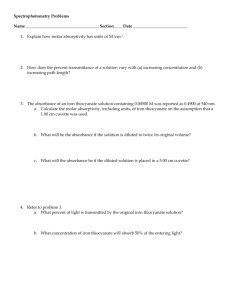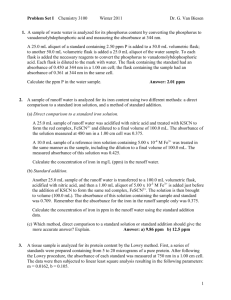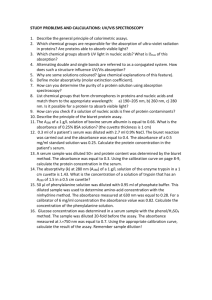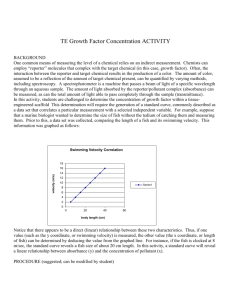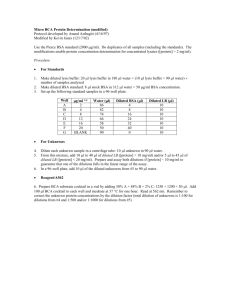Set1 practice final Calculate volume of the solution in cm3 in which
advertisement
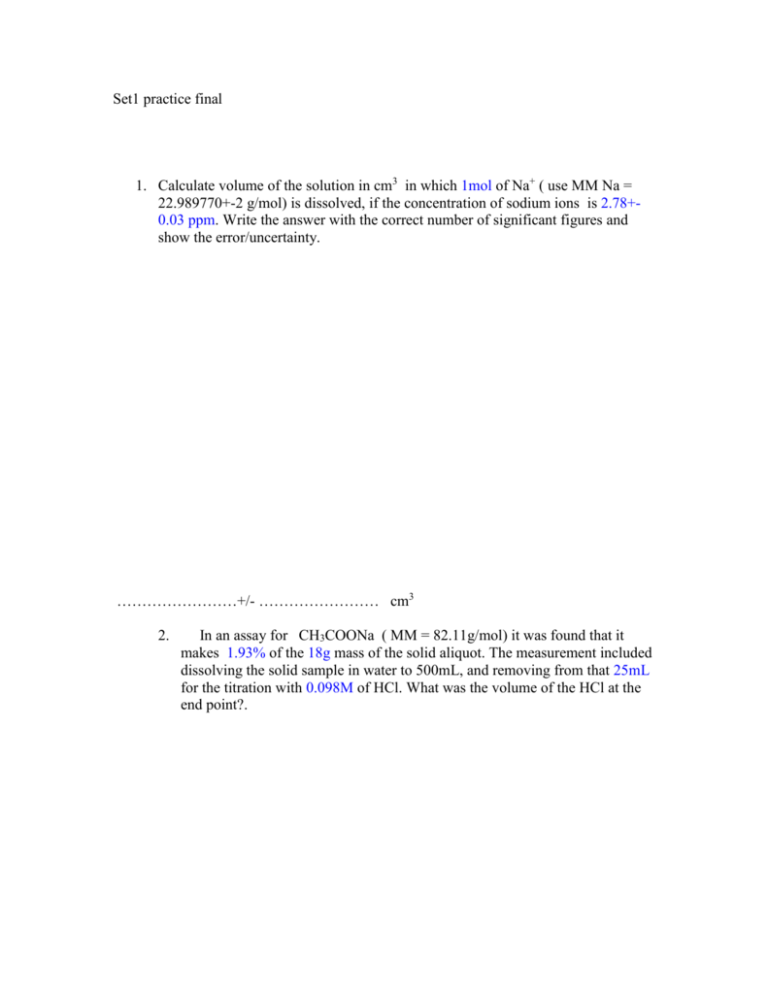
Set1 practice final 1. Calculate volume of the solution in cm3 in which 1mol of Na+ ( use MM Na = 22.989770+-2 g/mol) is dissolved, if the concentration of sodium ions is 2.78+0.03 ppm. Write the answer with the correct number of significant figures and show the error/uncertainty. ……………………+/- …………………… cm3 2. In an assay for CH3COONa ( MM = 82.11g/mol) it was found that it makes 1.93% of the 18g mass of the solid aliquot. The measurement included dissolving the solid sample in water to 500mL, and removing from that 25mL for the titration with 0.098M of HCl. What was the volume of the HCl at the end point?. ……………………………………………………………… L 3. The average (mean) of five (5) measurements is 3.77 ppm, standard deviation is 0.04 ppm. There is 95% probability that the true value is somewhere between (show lowest and highest values) Between ………………… and ………………………….. ppm 4. A new method was applied to the analysis of a drug. A sample with a know concentration of 42.25 ppm of protein was tested with the new method. The results of the eight (8) replicate determinations give mean of 42.20 ppm, and the percent relative standard deviation of these last measurements is 0.07 %. Is the mean of these eight trials significantly different from the known value at the 95% CL? Write for yourself down all your calculations, all relevant values from your calculations, and the reason for your decision! Calculated value tcalc= There is (circle one) a significant difference. YES NOT 5 Determine whether a significant difference has been demonstrated between the caffeine concentrations in grams per 100 grams of chocolate if two samples of two chocolates have sample 1: 0.402 +- 0.003 g/ 100g of chocolate, from 5 measurements sample 2: 0.397 +- 0.004 g/100g of chocolate, from 5 measurements t calculated………………………………………. There is a significant difference 6. Which of the following is TRUE YES NOT a) An analytical lab often uses electronic balances with accuracy of 0.0001g b) A decision weather or not to increase the number of measurements (n) using the same method depends on the size of systematic error c) Uncertainty/error in the measurement of volume of liquids is always done without calculations using propagation of error (draw yourself a picture of process) d) The conversion factor uncertainty/error in the expression: 1nm = 10-9m is 10-9m e) All are NOT TRUE letter ……………. 7. The light of a diode laser in your CD/DVD has a wavelength close to 480 nm. What is the frequency of that light? . ……………………………. Units:……………… 8. Calculate the absorbance A, if the power measured after the light source is 98 power units (power of the light source), and the power measured after the sample is 77 power units A = ………………………………………… 9. Choose (circle) from the list below all that is USED in the measurement of VISIBLE PHOSPORESCENCE. (you may want to draw for yourself the basic configuration of an instrument for that spectroscopic method): Drawing…………………………… a) hot wire b) singlet-triplet transitions c) monochromator d) PMT e) interferometer USED USED USED USED USED NOT USED NOT USED NOT USED NOT USED NOT USED Write letters for what is USED ……………………………………………………….. 10) Which molecular process(es) results in absorption of electromagnetic radiations used in FTIR measurements: process ………………………. 11. A sample of a colored (dye attached) protein has absorbance A= 0.612 at 240 nm in a quartz cuvet with 2 cm path length. Find the concentration of that protein if molar absorptivity is e = 772 M-1cm-1. ………………………………………. M………………. 12. What is NOT TRUE a. b. c. d. Fluorescence is a faster process than phosphorescence Fluorescence has one of the best detection limits for all spectroscopies Fluorescence can be measured with two monochromators Fluorescence spectrum of a molecule is at relatively higher energy than the absorption spectrum of the same molecule e. In Fluorescence measurements detector is positioned under 90o relative to the source-sample line letter for NOT TRUE……………. 13. Precisely 20.00mL of a solution containing Na+ is diluted to 100mL and that diluted solution gives a signal 2.5 in Atomic Absorption Spectroscopy analysis. As the signal was out of the linear domain of the instrument, 10 mL of that diluted solution was further diluted into 100mL of water, so that the signal was 0.62 units. Precisely 5.00mL of 1.5M NaCl was added to an empty volumetric flask and that was diluted to the mark, 100mL, with the previously diluted solution of Na+ (used for the acceptable signal). This new, spiked, solution gives a signal of 1.8 units, in the linear domain of instrument. What is the concentration of Na+ ? …………………………………………………………..M 14. A separation is performed using GC on a sample of an engine cleaner solution that contains unknown concentration of kerosene and no benzene. Firstly, a freshly prepared (standards) solution containing 330ppm of kerosene and 600ppm benzene gave peak areas of Aa=62 000 for kerosene and peak area of As=150 000 for benzene. If 25 mL of 1000ppm of benzene was added to the 20 mL of the engine cleaner sample with kerosene and then the mixture was diluted to 50mL in a volumetric flask, the peak area for kerosene was Aa =120 000 and for benzene was As =340 000. What is the concentration of kerosene in the solution? concentration of kerosene in the solution…………… ……ppm 15. Determine concentration C in M of a dye in a sample, if the absorbance of sample is 0.777 units, the absorbance of the blank is 0.017 units, and the calibration function is A= 0.551 C +0.007 C=…………………………….M ……………………………………………………………. 16. An analyte with retention time of 514 s has a width at the base of 40 s and the next peak is eluted at 560 s with 60 s width at the base. What is the resolution of these two peaks? resolution………………………………. 17. Write an example for each answer of what is used in HPLC chromatography a) A detector used: ………………………….. b) A mobile phase (substance) used: ………………………… c) Used in an application:……………………………….. 18.. Write an example for each answer of what is used in GC chromatography a) A detector used: ………………………….. b) A mobile phase (substance) used: ………………………… c) Used in an application:……………………………….. 19. Which of the proposed calibration methods would you use in the following applications: (put a letter from the applications in front of the calibration method) 1) ….. 2) …. 3) …. Standard addition Internal addition Linear calibration function a) GC (any) b) AAS (high precision) c) VIS absorption (unknown matrix) Letters for 1)………………., 2) ……………………., 3) ………………… 20. In HPLC, what is measured and presented as output from the instrument on the x axis, and what is presented on the y axis? x- axis: -------------------------------------y-axis: --------------------------- 21 Calculate the pH of a solution of 0.109 M base A- dissociated in water, if for the conjugated acid Ka (HA) =3.3 10-6? … pH …………………………………………………… 22.Calculate the concentration in molarity (M) of a week acid HA, if 180mL of 0.036M KOH is needed to titrate (equivalence point) 150mL of that acid. ……………………………………………………..M 23. Calculate the pH of a solution formed when 66mL of 0.2 KOH is added to the 80mL of 0.5 M HNO3. pH………………………………. 24. Calculate the pH of a solution with the following concentrations: 0.38 moles of acetic acid, 0.68 moles of sodium acetate. Ka of acetic acid is 1.8 10-5. pH……………………………………….. 25 . An analyte compound , named ACO, has molar mass MM= 289g/mole. The aliquot mass is 4.9011g. There are other materials in addition to that analyte in the aliquot. When the sample is dissolved in a solvent and diluted to 250mL , another smaller 25.00mL aliquot is removed and transferred to 500mL volumetric flask and diluted to the mark. The mixture obtained has absorbance of A= 0.690 at 440nm light in a 2 cm cuvet cell. No interferents are found and the blank absorbance is 0.020. The molecular absorption coefficient e = 15130 L/mole-cm-1. Calculate the mass % of the analyte compound, ACO in the sample. % mass (wt/wt)………………………………………….% Set 2Practice final 2 Constants h=6.626 10-34 Js , c= 2.9979 108 m/s Question 1 : 1. Calculate the M(molarity) of the analyte AAA if 0.122+-0.001mol and the analyte is dissolved in 250.0+-0.5 mL of water. Write the answer with the correct number of significant figures and show the uncertainty for number of grams. ……………………+/- ……………………mol/L number only : = 0.488 +-0.004 Question 2 : Percent (%) relative standard deviation is a) same as standard deviation, s b) ratio between s and mean value X, s/X c) s/X * 1000 d) s/X *100 letter: = D Question 3 : In GC with FID detector, which of these is measured and presented as output from the instrument on the x axis, and which is presented on the y axis? a) x= wavelenght, y=absorbance b) x= time, y= concentration d) x=time, y= number of ions e) x= wavenumber, y= transmitance letter = d Question 4 : What is the best method to measure concentrations of gold in antitumor drugs choose one of those (FTIR, VIS, AAS, GC, HPLC) = aas Question 5 : What is the transmittance if absorbance is 0.9 A=…0.126… Question 6 : For 333nm calculate…………. Energy = 5.97 E-19 J frequency = 9 E 14 s-1 Question 7 : What atomic or molecular process is responsible for the production of 333nm a) nuclear vibrations b) electron transitions in atoms or molecules c) rotations of nuclei d) nuclear transmutations letter= b Question 8 : Which of the following is not used in FTIR a) cm-1 b) hot wire c) interferometer d) diffraction grating c) transmittance letter= d… Question 9 : Determine whether a significant difference has been demonstrated between experimental means X1 and X2 at 95% of confidence level. X1=41.3 X2=41.6 n1 =5 n2 =4 s1=.23 s2=.25 t calculated/found = 1.87 (number) write YES or NO : NO Question 10 : A new method was applied to the analysis of a metal. A sample with a know concentration of 1.12 ppm of metal was tested with the new method. The results of the six (6) replicate determinations give mean of 1.09ppm, and the percent relative standard deviation of these last measurements is 0.44%. Is the mean of these six trials significantly different from the known value at the 95% CL? t calc/found -= 15.3 (number) YES or NO YES Question 11 : 1. What is the average (mean) value, standard deviation and what is CI (confidence interval) at 95% of CL, if the measurements give these results: 22 .7, 23.3, 21.9, 22.2, 23.1 , 21.7 the mean 22.5 standard deviation 0.7 confidence interval = +- 0.685 percent relative standard deviation 2.9 % did the Q test eliminate any number YES NO =NO Question 12 :A sample of 0.1M analyte has absorbtivity of 4334M-1cm-1at 540nm in a quartz cuvet with 1cm pathlength. Find the absorbance , A= . number= 433.4 Question 13: 11. Determine how many M of an analyte is in the unknown sample if the absorbance of sample is 0.49 and the calibration function is A= 0.84 C +0.02 and the absorbance of the blank is 0.09. number= 0.45 Question 14: NO QUESTION number= Question 15: An analyte with retention time of 134s has a width at the base of 20s and the next peak is eluted at 250s with 30s width at the base. What is the resolution of these two peaks number= 4.64 Question 16 : The length of a column in the HPLC chromatography is about 50m YES, NO = NO Question 17: The normal phase in HPLC is the one where the stationary phase is more polar YES/NO= YES Question 18: Internal standard addition is particularly needed in GC YES/NO= YES Question 19: 20) Calculate the pH of a 30mL solution of 0.091M acid A dissociated in water, if Ka (HA) =7.3 10-6? number= 3.09 Question 21: Calculate the concentration in molarity (M) of a week acid HA, if 75mL of 0.085M NaOH is needed to titrate (equivalence point) 50mL of that acid. number= 0.128 Question 22: Calculate the pOH of a solution formed when 46mL of 0.1 a strong acid is added to the 40mL of 0.2 M strong base. number= 1.4 Question 23: Calculate the pH of a buffer with the following concentrations: 0.3M of weak acid, 0.3M of the salt of that acid. Ka of the acid is 7.8 10-5. number= 4.11 Question 24: 10.00mL of a solution containing a metal ion M+ is diluted to 150mL and that diluted solution gives a signal 3.5 in AAS analysis. As the signal was out of the linear domain of the instrument, 5 mL of that diluted solution was further diluted into50mL of water, so that the signal was 1.72 units.. 1.00mL of 0.5M metal salt was added to an empty volumetric flask and that was diluted to the mark, 150mL, with the previously diluted solution of the metal. This new, spiked, solution gives a signal of 2.8 units, in the linear domain of instrument. What is the concentration of the metal? number= x= 0.788 Question 25: A separation is performed using GC on a sample of vine that contains unknown concentration of ethyl alcohol and no isopropyl alcohol. Firstly, a freshly prepared (standards) solution containing 230ppm of ethyl alcohol and 500ppm isopropyl gave peak areas of Ia=33 000 for ethyl alcohol and peak area of Is=80 000 for isopropyl alcohol. If 5mL of 500ppm of isopropil alcohol was added to the 10mL of the vine sample and then the mixture was diluted to 25mL in a volumetric flask, the peak area for vine was Ia =100 000 and for isopropyl alcohol was As =160 000. What is the concentration of ethyl alcohol in vine……… ………………………ppm number= 174.2

